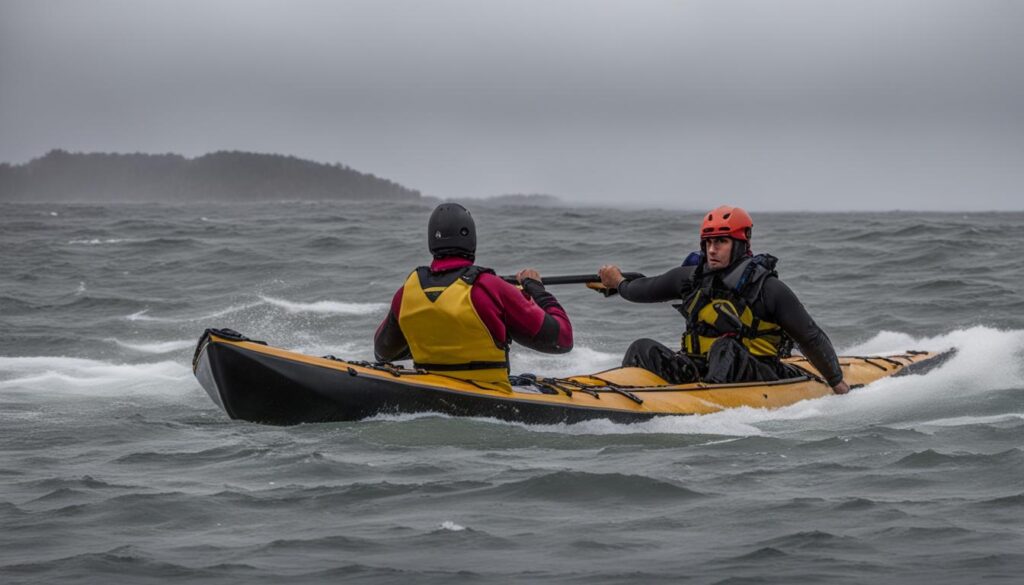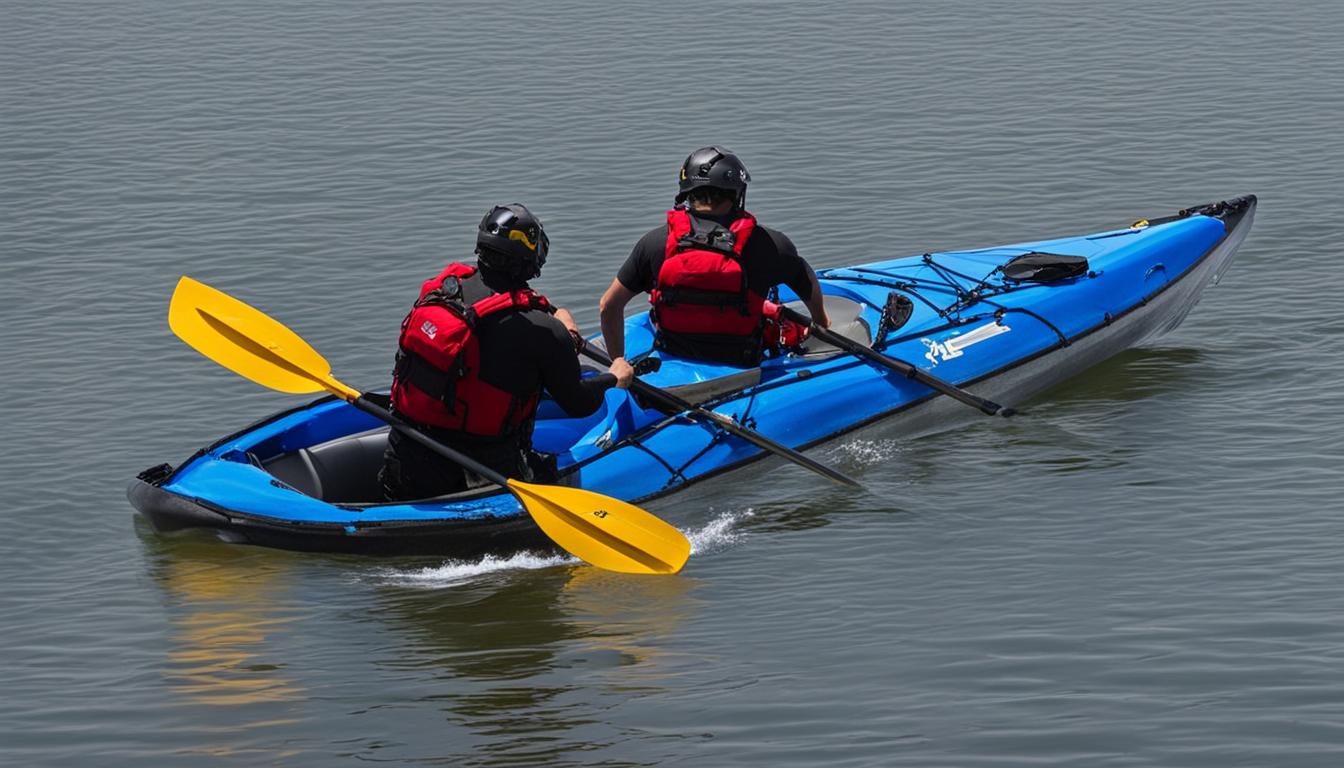When it comes to kayak safety, knowing how to assist in T-rescues is essential. Whether you’re a beginner or experienced kayaker, understanding the techniques involved in T-rescues can make all the difference in emergency situations. In this article, we will guide you through the step-by-step process of assisting in T-rescues, from the initial steps after capsizing to repositioning the kayaks for stability. By learning and practicing these techniques, you can enhance your kayak safety skills and be prepared to handle T-rescues in different scenarios, including tandem kayak T-rescues, group rescues, and swift water situations.
Key Takeaways:
- Assisting in T-rescues requires teamwork, communication, and practice.
- Follow the step-by-step process of T-rescues to ensure efficiency and safety.
- Seek proper instruction and practice in a variety of conditions to build experience and proficiency.
- Reposition kayaks to create a stable platform for both the rescuer and the swimmer.
- Remember to stay calm and focused during T-rescues to maintain safety for everyone involved.
First Steps After Capsizing
After capsizing in a kayak, it’s important to stay calm and take immediate action to ensure your safety. Knowing the first steps to take after capsizing can greatly increase your chances of a smooth recovery. Here are some essential tips to keep in mind:
- Perform a wet exit: When you find yourself in the water after capsizing, it’s crucial to exit the kayak safely. To do this, locate the kayak’s spray skirt and release it. Then, tuck forward and lean to the side to slide out of the cockpit. Remember to keep a firm grip on your paddle.
- Signal for assistance: After performing a wet exit, it’s important to signal for help. Raise your hand or paddle in the air to attract the attention of nearby kayakers or rescue teams. Don’t hesitate to ask for assistance if needed.
- Retrieve your gear: Once you are safely out of the kayak, retrieve any loose gear that may have floated away. This includes your paddle, personal items, and any essential equipment.
- Stay with your kayak: It’s essential to stay close to your kayak after capsizing. Your kayak can provide flotation and visibility to rescuers. By staying near your kayak, you also ensure that you have access to essential gear and equipment.
By following these first steps after capsizing, you can maintain your safety and increase your chances of a successful recovery. Remember, practicing these steps in a controlled environment and seeking professional instruction can greatly enhance your paddling safety skills.

Righting the Capsized Kayak
After successfully positioning the overturned kayak, the next step in a T-rescue is to right the capsized boat and empty water from the cockpit. This crucial maneuver not only restores stability but also ensures that the rescued kayak is ready for reentry. Follow these steps to effectively right the kayak:
- Swim to the back of the overturned kayak and position yourself in a stable position.
- Push up on the kayak while the rescuer lifts and slides the bow onto their boat. Coordinate your movements to ensure a smooth and controlled action.
- Once the bow is securely placed on the rescuer’s boat, start rocking the overturned kayak back and forth to empty the water from the cockpit. This motion helps displace the water and improves the kayak’s buoyancy.
- Continue rocking the kayak until it is completely emptied of water. This may require several repetitions depending on the amount of water accumulated.
By following these steps, you will successfully right the capsized kayak and prepare it for reentry. It is essential to practice this technique in a controlled environment with proper guidance to build confidence and proficiency in performing T-rescues.
Benefits of Righting the Capsized Kayak
Righting the capsized kayak is a critical aspect of T-rescues that offers several benefits:
- Improved Stability: By emptying the water from the cockpit, the kayak regains its stability, making it easier for the swimmer to reenter.
- Enhanced Buoyancy: Removing the water enables the kayak to float higher on the surface, reducing the risk of further capsizing.
- Reduced Water Drag: A water-filled cockpit increases drag, making paddling more challenging. Emptying the water restores the kayak’s hydrodynamic efficiency.
- Increased Safety: A righted kayak ensures a safer environment for both the swimmer and the rescuer, minimizing the chances of accidents or injuries during the rescue process.
Remember, proper technique and practice are key to successfully righting a capsized kayak. Regularly honing your skills will enhance your ability to handle T-rescues and contribute to a safer kayaking experience overall.
Repositioning the Kayaks
Once the capsized kayak has been righted and the water has been emptied from the cockpit, the next step in assisting in a T-rescue is repositioning the kayaks to create a stable platform. This is crucial to ensure the safety of both the swimmer and the rescuer.
To create stability, the rescuer should carefully reposition their boat parallel to the righted boat, with the bow of the rescuer’s kayak next to the stern of the righted boat. This formation allows for better control and balance during the re-entry process. It is important for the rescuer to maintain a firm grip on both boats to prevent any accidental separation.
One effective technique for stabilizing the kayaks is for the rescuer to lean in and grab onto the cockpit coaming and deck lines of both boats. This provides additional support and helps to minimize any potential rocking or instability. By maintaining this grip, the rescuer can ensure that the boats remain steady while the swimmer prepares to re-enter the kayak.

Remember, teamwork is essential during a T-rescue. Effective communication and coordination between the swimmer and the rescuer are crucial for a successful re-entry. By repositioning the kayaks in a stable formation and maintaining a firm grip, both the swimmer and the rescuer can work together to ensure a safe and smooth re-entry process.
Conclusion
Assisting in T-rescues is a vital skill for every kayaker looking to enhance their kayak safety. By following the techniques outlined in this article, you can become proficient in T-rescue and develop essential kayak rescue skills.
Remember, teamwork and communication are key when performing T-rescues. Practice these techniques in a safe environment with experienced guidance to build your confidence and proficiency.
Investing time and effort into learning T-rescue techniques will significantly contribute to a safer and more enjoyable paddling experience. Prioritize kayak safety by seeking proper instruction and continuing to practice in various conditions.
So, equip yourself with the right knowledge, refine your skills, and be prepared to lend a helping hand in T-rescues. With a commitment to kayak safety and T-rescue techniques, you can navigate the waters with confidence and peace of mind.
FAQ
What are the first steps to take after capsizing in a kayak?
After capsizing, it’s crucial to stay calm and perform a wet exit. The rescuer should paddle towards the overturned boat.
How do you right a capsized kayak?
To right a capsized kayak, the rescuer positions their boat perpendicular to the bow of the capsized boat and the swimmer pushes down on the back of the capsized boat while the rescuer lifts and slides the bow.
How do you reposition the kayaks after righting them?
To reposition the kayaks, the rescuer should parallel their boat to the righted boat, with the bow next to the stern. They can stabilize the boats by leaning in and grabbing the cockpit coaming and deck lines.
What skills are needed to assist in T-rescues?
Assisting in T-rescues requires teamwork, communication, and practice. It’s important to seek proper instruction and practice in a variety of conditions to build experience and proficiency in T-rescue techniques.
How can I enhance my kayak safety skills?
By following the steps outlined in this article and practicing T-rescues, you can effectively enhance your kayak safety skills. Seek proper instruction and practice in a variety of conditions to build experience and proficiency.





